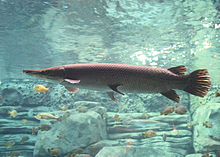Alligator gar
| Alligator gar | |
|---|---|
 |
|
| Alligator gar in an aquarium | |
| Scientific classification | |
| Kingdom: | Animalia |
| Phylum: | Chordata |
| Class: | Actinopterygii |
| Order: | Lepisosteiformes |
| Family: | Lepisosteidae |
| Genus: | Atractosteus |
| Species: | A. spatula |
| Binomial name | |
|
Atractosteus spatula (Lacépède, 1803) |
|
 |
|
| Synonyms | |
|
Lepisosteus spatula Lacépède, 1803 |
|
Lepisosteus spatula Lacépède, 1803
Atractosteus adamantinus Rafinesque, 1818
Alligator gar (Atractosteus spatula) are ray-finned euryhaline fish related to bowfin in the infraclass Holostei (ho'-las-te-i). The fossil record traces their existence to the Early Cretaceous over a hundred million years ago. They are the largest species in the gar family, and among the largest freshwater fishes in North America. Gars are often referred to as "primitive fishes", or "living fossils" because they have retained some morphological characteristics of their earliest ancestors, such as a spiral valve intestine which is also common to the digestive system of sharks, and the ability to breathe both air and water. Their common name was derived from their resemblance to American alligator, particularly their broad snout and long sharp teeth. Anecdotal evidence in several scientific reports suggest that an alligator gar can grow up to 10 ft (3.0 m) in length and weigh as much as 300 lb (140 kg); however in 2011 the largest alligator gar ever caught and officially recorded was 8 ft 5 1⁄4 in (2.572 m) long, weighed 327 lb (148 kg), and was 47 in (120 cm) around the girth.
The body of an alligator gar is torpedo shaped, usually brown or olive fading to a lighter gray or yellow ventral surface. Their scales are not like the scales of other fishes; rather, they are ganoid scales which are bone-like, diamond-shaped scales, often with serrated edges, and covered by an enamel-like substance. Ganoid scales are nearly impenetrable and are excellent protection against predation. Unlike other gar species, the upper jaw of an alligator gar has a dual row of large sharp teeth which are used to impale and hold prey. Alligator gar are stalking, ambush predators, primarily piscivores, but they will also ambush and eat water fowl and small mammals they find floating on the water's surface.
...
Wikipedia
